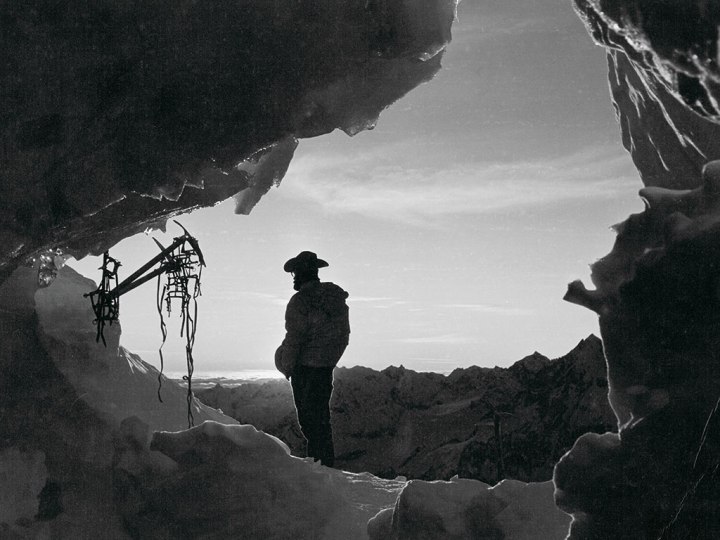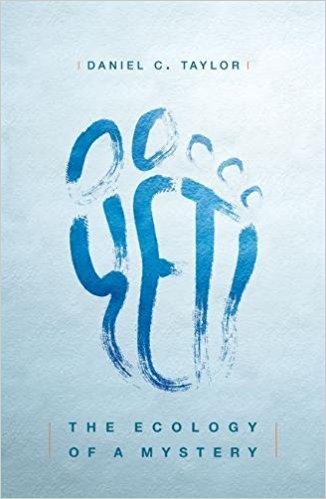Searching for the Yeti
Posted by: Craig Woolheater on August 15th, 2017

The author in an ice cave at 19,000 feet in Gosainkund Himalaya. Photo Courtesy: Daniel C. Taylor/YETI/Oxford University Press
There is a Yeti animal. But explaining the animal mystery turns out not to explain the Yeti’s story.
As an 11-year old, I saw a footprint in a newspaper—it was called “Yeti,” the article said. The expert being quoted was a museum curator in England, and he said the footprint was made by langur monkeys. Others in that newspaper article said the footprint was made by an “Abominable Snowman”.
But even at 11 years, having by then spent hundreds of days in the Indian jungle, I knew the English museum curator to be wrong … and, I became excited. If there was a mysterious Yeti or Abominable Snowman, I wanted to find it. The unknowns of the Himalaya were literally out our back door.
And from that newspaper article in 1956 began my half century of travels across the Himalayan spectacular—searching for the Yeti. After 27 years, I found the explanation of what made the mysterious footprints in the snow. There is a Yeti animal. But explaining the animal mystery turns out not to explain the Yeti mystery. To understand that mystery I have been searching continually for 51 years; after finding the animal I led in starting a series of national parks. This search I have just now described in my new book Yeti: The Ecology of a Mystery (Oxford University Press).
The Yeti animal is real, as I describe in the book, because it makes real footprints. (Spirits do not make footprints, neither do myths—so finding footprints means a real animal.) The Yeti idea, though, is also real because this equally real Yeti stands as an icon of the wild. An icon is an image of a great natural force, the same way that an idol also is a valid force … say an idol of Hanuman.
The Yeti symbolises the mysteries of the Himalaya. To understand the mysteries of the Himalaya, it is helpful to properly redefine the word Himalaya. When the British came on their conquest of the Indian subcontinent they were fascinated by the great mountains wanting to also conquer them. And as mountains have plural names (Alps, Rockies, Pyrenees, Andes), they gave the name Himalayas. But to the people of the subcontinent the Himalaya were “an abode of snow” (Himalaya). It was into the abode of snow that pilgrims went to for enlightenment, from where sacred waters flowed that nourished life on the flat plains, even where Hanuman scampered for medicinal healing. So, in my half-century quest, the place where I searched is called Himalaya rather than the conquest suggested by Himalayas.
I kept searching. First, discoveries were in the hills outside our home in Mussoorie, venturing off even into the Kulu Valley. I carried with me photographs of the mysterious Yeti footprints in the snow. Through the years of the 1950s, I talked with villagers and traders exchanging stories about the Yeti I had read in newspapers and books … and to my sorrow, they told me there was no such animal. But there was, I knew. Footprints had been made. Only real animals make footprints, and these footprints had been repeatedly photographed in varying sizes (indicating a population of Yetis, some monsters with 14-inch prints, some juvenile with 7-inch prints).
Like the glaciers of the Himalaya—finding these footprints was an enduring feature of my walking through the 2,896-kilometres wide region—the enigmatic unexplainable footprints in their varying sizes had been found for over one hundred years since the late 1800s. Sadly, we now know that the glaciers that have so long endured are melting due to the effluent of our human affluent because we are conquering Nature’s balances—this knowledge of the disappearing Nature became at first a greater discovery … then I found how as people we could rediscover Nature (and protect it).
My travels moved from the Indian Himalaya to Bhutan in 1961, entering that land on horseback before the roads were made. I was exploring and searching for the Yeti. The wise third king of Bhutan told me he thought the Yeti was a Blue Bear, an animal not known on the south Indian/Bhutanese/Nepali slope of the Himalaya. Indeed a quasi-mythical bear of northern Tibet, but mythical only because it had never been “scientifically collected,” yet still was a known bear because skins had been brought out of the mountains.
Even in the 1960s as I searched, the Himalaya was largely an unknown region. There were unknown valleys still, places with habitation to be sure, but where we did not know who the inhabitants were, or they of us. We were conquering the mighty summits for the first time during these years… and, interestingly, when mountain conquests were unsuccessful, often evidence of the mysterious Yeti was footprints found in the skirts of glaciers at their bases. Climbers unsuccessful in their conquests kept the mystery alive.
From 1968 through the 1970s and into the 1980s I was able to search the breadth of the Nepal Himalaya—and because I worked in the family planning programme, I had the use of a helicopter. So at times I would be left off in the most remote of mountain passes, then walk out. Yes, it became clear, multiple Yetis existed; the Yeti existed as an animal and icon.
Then the answer became clear for the animal itself. It lived in trees. It was black not white. The mysterious footprint was actually an overprint of hind paw onto front. Indeed, I was able to tranquilise the animal—and with a specimen comfortably so sleeping, I was then able to imprint its feet into plaster to replicate all the most enigmatic mysterious footprints that had been found in the glacial snows across the earlier decades.
Does explaining the footprint explain the mystery? The Yeti is a call of the wild, calling from deep inside us. I found that I could call this physical animal (sometimes) to visit my jungle high camps (peanut butter seems to work best, placed on windy ridges to allow its aromas to waft through the forests). The animal is of the Himalayan forests—it becomes a snowman when it crosses a mountain to see what it can see (or eat, or have sex).
But, no, this is not the answer also. When I gave lectures in the 1980s around the world, and in illustrious halls such as at the Royal Geographical Society—even a learned audience did not want to know what the animal was that makes the mysterious footprints in the snow. It was OK to give hints, but please don’t tell us what the animal actually is.
Daniel C. Taylor is a Harvard alumnus and the author of YETI. He is currently the President of Future Generations University. In recognition of his conservation work he has been honoured by the King of Nepal, the Chinese Academy of Sciences, and Prince Bernhard of The Netherlands.
Read the entire article with photos here
This book explains the mystery of the Yeti or Abominable Snowman, the creature that has left mysterious footprints in Himalayan snows. The book also explores why people are so fascinated with the possibility that a wild hominoid might still reclusively live (the idea of a wild humanity alive in people’s hopes). Here also is the extraordinary story of one man’s conservation impact-a quest for mysterious animal caused him to lead in creating two massive national parks around Mount Everest, one in China/Tibet and one in Nepal.
This book narrates how the author explores much of the 2,000-mile breadth of the Himalaya, from his childhood in India to his work years in Nepal, China/Tibet, and Bhutan. From 1956 until 2015 he visited almost all valley systems. The book recounts his ascents of Himalayan summits and even a first descent of a major river, Nepal’s Sun Kosi.
This book not only explains scientifically the Yeti and describes a range of Himalayan animals and plants, it also brings forward a wide scope of ecological understanding. Significant among these is the author’s postulate about bioresilience as a parallel dynamic to biodiversity. Additionally, the author explores what it means (and how important it is) for people to be part of ‘the wild’ in today’s increasingly domesticated world. Taylor’s breadth of Himalayan knowledge is massive, the story captivating and full of surprises-and what he has accomplished includes ‘discovering’ the Yeti as well as creating two huge national parks.
About Craig Woolheater
Co-founder of Cryptomundo in 2005.
I have appeared in or contributed to the following TV programs, documentaries and films:
OLN's Mysterious Encounters: "Caddo Critter", Southern Fried Bigfoot, Travel Channel's Weird Travels: "Bigfoot", History Channel's MonsterQuest: "Swamp Stalker", The Wild Man of the Navidad, Destination America's Monsters and Mysteries in America: Texas Terror - Lake Worth Monster, Animal Planet's Finding Bigfoot: Return to Boggy Creek and Beast of the Bayou.










So what is the species you’re talking about?
after seeing the expedition unknown series on the yeti… i’m totally convinced it’s possible for something to maybe have lived there, untouched by man, for a long long time…
there’s so much area there thats untouched by man…. anything is possible.
they said some early type of human ancestors could have lived there in that region, with zero contact or contamination from the outside world.
its pretty trippy to think about.
is it a bear species as claimed?
is it a “bigfoot” type thing?
I have no clue
but i’d love to find out 🙂
Clouded Leopard – read the linked article for details. Cool research.